Optimal Lighting Solutions for Small Kitchens
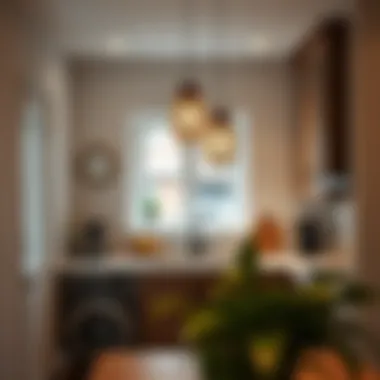

Intro
In small kitchens, lighting plays a pivotal role in creating a functional and aesthetically pleasing environment. Unlike larger spaces, where one can afford to be extravagant with fixtures and brightness, compact cooking areas require a strategic approach. Homeowners often face the challenge of balancing illumination with space efficiency. This article will delve into various lighting types and techniques that can transform a small kitchen from a dimly lit area into a vibrant hub. By focusing on practical guidance and current trends, this guide aims to illuminate the paths to making the most out of limited square footage.
Design Inspiration
Creating a cohesive design narrative can be crucial in making the most of a small kitchen. It’s not just about adding light; it’s about creating ambiance and enhancing the overall look.
Trending Styles
When it comes to styles, contemporary, minimalist, and industrial designs are very much in vogue. For instance, industrial-style kitchens often employ exposed bulbs and metallic fixtures, creating a stark yet inviting vibe. Alternatively, a minimalist approach emphasizes clean lines and functionality, using streamlined fixtures that don’t clutter the visual field. The idea is to blend style with practicality.
- Contemporary: Think sleek, simple shapes and bright LEDs.
- Industrial: Combine metal fixtures and Edison bulbs for a rugged feel.
- Minimalist: Go for hidden lighting, such as under-cabinet strips, to maintain openness.
Color Palettes
Color also has a significant impact on perception. Lighter hues reflect light better, making a space feel bigger and more open. Whites, creams, and soft pastels can work wonders. Furthermore, incorporating a pop of color in your fixtures can add personality without overwhelming the room. For example, a vibrant pendant light against a white backdrop can serve as a focal point without making the room feel cramped.
Key Takeaway
Light colors not only make the space feel roomier, but they also amplify the effect of natural light.
Practical Tips
Crafting an inviting atmosphere involves more than selecting stylish fixtures. Practical strategies also come into play to ensure that light is both effective and economical.
Maintenance & Care
Regularly cleaning light fixtures can significantly enhance their performance. Dust and grime can dull the brightness, especially in small kitchens where every bit of light counts. Consider using damp cloths or specialized cleaning solutions suitable for each material to keep lights shining bright. Moreover, replacing bulbs promptly, especially with energy-efficient options like LED, can not only save on electricity but also ensure there’s no flicker to dim the mood in your kitchen.
Budgeting & Planning
Lighting can be an investment, but careful planning can ensure you maximize your budget. It’s wise to prioritize functional lighting in key areas, such as above sinks or along countertops, and supplement with ambient or decorative fixtures. Make a list of essential needs versus wants to avoid overspending. For example, adding swag lights or track systems isn’t just fashionable; it’s practical as well and does not consume much space.
Closing Thoughts
In planning your small kitchen’s lighting, consider both style and functionality. Clever choices can turn an ordinary kitchen into a well-lit culinary haven, allowing every dish to shine. Keep both current trends and practical strategies in your toolkit as you work towards a bright and inviting space. For further love on kitchen design, consider resources at Wikipedia or Britannica.
Understanding the Importance of Lighting in Small Kitchens
When it comes to cooking spaces, lighting is more than just a functional necessity; it's a crucial element that can make or break the overall experience of your kitchen. In smaller kitchens, where every inch matters, a well-thought-out lighting design can enhance not only visibility but also the space's character. Proper lighting serves dual purposes: it showcases your decor while allowing you to navigate safely and efficiently while prepping meals.
Functionality vs. Aesthetics
One might argue that functionality should take precedence in kitchen design, especially in compact areas. After all, you're chopping vegetables, simmering sauce, and occasionally fending off pesky kitchen fires. However, overlooking aesthetics can lead to a space that feels sterile and uninviting. Kitchen lighting, therefore, should strike a balance between these two aspects.
Consider under-cabinet lights, which provide the necessary illumination for food prep without overwhelming the visual appeal of the kitchen. Such fixtures can not only enhance your efficiency but also act as a subtle way to elevate the overall atmosphere. Think of them like the perfect pair of shoes; they need to be comfortable for walking while also leaving a lasting impression.
Moreover, adding layers of light—ambient, task, and accent—enriches the visual interest without overshadowing practicality. The key is to curate light that focuses on work zones while still providing a warm glow that welcomes gatherings, turning a cookie-cutter area into a culinary haven.
The Role of Mood and Ambiance
Lighting has a transformative power in setting the mood. In a small kitchen, it can either serve as a bright, crisp environment where you whip up quick dinners or transform into a cozy nook for intimate gatherings. The correct light can set the stage for both chaos and calm.
Imagine sitting at a breakfast nook under soft pendant lights while you sip your morning coffee. Or picture a bustling dinner prep illuminated by bright task lighting that sharpens your focus and energizes your efforts. Both scenarios underscore how light can sculpt emotional experiences within your cooking space.
Good lighting not only provides an overall glow but also influences how you feel in this central area of your home. It's the unsung hero of kitchen design.
In summary, the significance of lighting in small kitchens cannot be overstated. The right combination of practical light solutions and ambient fixtures can ensure that the space doesn't just meet functional needs but enhances your enjoyment and connection to it. Make choices that reflect your style while keeping practicality in mind, and don't shy away from experimenting until you find that perfect balance. The right lighting elevates the ordinary into something extraordinary, making cooking a joyous endeavor rather than a chore.
Natural Light: Maximizing Sunlight in Compact Spaces
In the world of small kitchens, light becomes a vital player, not merely a convenience. Maximizing natural light brings a certain vitality to these often limited spaces, ushering warmth and openness. A well-lit kitchen can alter mood, improve functionality, and effortlessly enhance even the tightest of quarters. For homeowners yearning for functionality combined with charm, this aspect of kitchen design deserves some serious consideration.
The benefits of harnessing daylight can't be overstated. It presents a pathway to engage with the outside while minimizing reliance on artificial lighting during daylight hours. When sunlight streams in, it connects the indoors with the outdoors, creating a lively atmosphere that can invigorate even the most mundane of cooking tasks. Not to mention, natural light plays a significant role in the perception of size; rooms drenched in sunlight feel larger and more inviting.
Yet, many linger in the shadows of average design, neglecting strategic elements that boost daylight incorporation. Thoughtful window placements, reflective surfaces, and other smart choices can do wonders for expanding that daylight flow. Home chefs, design enthusiasts, and anyone who frequently hosts gatherings will find this guide beneficial in understanding how to keep kitchens both bright and cozy, while maintaining an artful touch.
Window Placement Considerations
The very first step in maximizing natural light hinges on the positioning of windows. Where you place them can either embrace the sunlight or send it packing. It’s about taking full advantage of the surroundings while maintaining elements of realism.
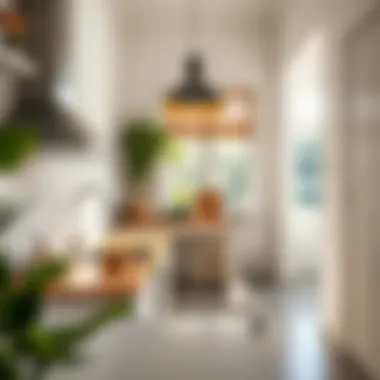

Consider the layout of your kitchen and neighboring spaces. If there's outdoor space outside, you might explore opting for larger windows or even doors that open up directly to patios or gardens. For instance, floor-to-ceiling windows can provide an extensive view while flooding the kitchen with light, transforming it into a vibrant hub for cooking and entertaining.
Additionally, if a kitchen faces north, you might find the light softer and more diffuse, making it perfect for creating a calm ambiance. In contrast, southern-facing windows capture bright beams throughout the day, which could be a double-edged sword if the heat becomes overwhelming. Aim to incorporate elements like blinds or shades that can control how much light you let in, allowing for versatility throughout the day.
Engaging with the outdoors can redefine your kitchen experience. Consider placing your windows not just for light, but as a pass-through to nature.
Using Reflective Surfaces
After you’ve got your windows set right, the next trick up your sleeve lies in the use of reflective surfaces. These surfaces act like helpful allies in your quest for light enhancement. Think about how light operates— it bounces and refracts, creating layers of brightness that can alter perceptions entirely.
Incorporating glossy tiles or shiny backsplashes can magnify the sun’s punch. A glossy white finish on cabinets, for example, can enhance illumination, redirecting any incoming light throughout the room. Mirrors are another smart addition. Placing them strategically, especially across from windows, can serve to double the perceived brightness, effectively spreading daylight across dark corners.
Moreover, lighter-colored countertops and furniture can create a fresher feel while making the whole space appear more open. On the flip side, avoid dark finishes which have the tendency to absorb light—this can create a heavy atmosphere that contradcts your intentions. It's all about balance, keeping in mind where you want the light to flow.
Types of Lighting Fixtures for Small Kitchens
Selecting the right lighting fixtures in a small kitchen is paramount for enhancing both utility and aesthetic appeal. Fixtures play a critical role in illuminating workspace, showcasing design elements, and ultimately creating a welcoming atmosphere. In a compact cooking space where each inch counts, the balance of function and style holds significance. This section dives into various fixture types that not only brighten up the kitchen but also aligns with modern tastes, making every meal prep a pleasant experience.
Ceiling Fixtures: Choosing the Right Style
Ceiling fixtures often serve as the primary source of illumination in any kitchen. Choosing the right style can transform a small space from dull to dynamic. Consider flush-mount fixtures, which are not only space-saving but also provide a clean look—an ideal fit for tight setups. These types of lights are particularly beneficial as they eliminate any obstruction from overhead cabinets or shelves.
Moreover, larger pendant lights can be strategically placed over kitchen islands or dining nooks, acting as focal points that draw the eye upward. A striking pendant light in a contrasting color can serve as a statement piece, injecting personality into the kitchen. However, size matters; oversized pendants can make an already small kitchen feel cramped. Thus, always measure the space before making a selection to ensure it complements rather than overwhelms.
"A well-chosen ceiling fixture can be the cherry on top of a small kitchen’s design."
Under-Cabinet Lighting: Practical Solutions
Under-cabinet lighting is an invaluable fixture type for small kitchens. It effectively adds layers of light that task lighting alone may not provide. Positioning these fixtures directly under shelves or cabinets can create direct illumination on countertops, making meal preparation easier and safer—especially when chopping or working with sharp utensils.
There are various options, such as LED strip lights, which can be cut to fit specific lengths or puck lights that can be used for targeted lighting. Both styles offer ease of installation and energy efficiency, making them a smart choice. Not only that, but they can also add a touch of ambiance, casting soft glows that elevate the overall mood of the space.
Pendant Lights: Adding Character
Using pendant lights in a small kitchen can be a game changer. They bring a sense of style and personality that can often be lacking in standard fixtures. Unlike traditional ceiling lights, pendants allow for creativity in design and placement. For instance, one can opt for an industrial-style fixture to bring a touch of vintage charm, or sleek glass globes for a more contemporary feel.
When considering the arrangement, hang them at varying heights to create visual interest. This way, the kitchen doesn’t just serve functional purposes but also tells a story about the homeowner’s style. Just remember, focusing on the scale and volume is crucial; choosing a pendant that’s too large can overshadow the compact space and detract from functionality.
In summary, the right lighting fixtures can harmonize practical needs with the visual appeal of small kitchens. Paying attention to the nuances of your choices can yield surprising results, even in the tightest of spaces.
By exploring ceilings, under-cabinet, and pendant fixtures, one can craft a kitchen environment that's not just bright but also synonymous with personal flair.
For more inspiration, consider checking resources like Wikipedia, and Britannica.
Proper selection of lighting enables homeowners and design enthusiasts alike to maximize the potential of their small kitchens, giving them both functionality and an inviting vibe.
Layered Lighting Approaches
When it comes to small kitchens, layered lighting is like the secret sauce — it brings harmony, depth and a bit of drama to the space. The blend of ambient, task, and accent lighting not only allows light to bounce around effectively but also makes the kitchen feel larger and more welcoming. Rather than just relying on a single source of light, a mix provides flexibility and caters to different needs throughout the day. Imagine preparing breakfast under bright task lighting and then transforming the atmosphere for evening gatherings with softer hues. It’s about versatility.
Ambient Lighting Basics
Ambient lighting, often referred to as general lighting, sets the stage. It's like the base coat in painting — you need a solid foundation before adding more colors. In small kitchens, choosing the right ambient lighting can create a warm and inviting atmosphere.
Types of ambient lighting:
- Flush-mounted ceiling fixtures: These are perfect for low ceilings, giving a clean look without taking too much space.
- Recessed lights: Installed in the ceiling, they provide unobtrusive lighting that’s adjustable. This can really make a closed-in space feel more open.
- Wall sconces: These offer both decorative appeal and additional light; they can cast light upwards or downwards, enhancing both functionality and aesthetics.
When selecting ambient options, consider how much natural light your kitchen receives. An overly bright environment can feel glaring, while too dim may not illuminate working areas properly. Aim for a warm white light (around 2700K to 3000K); this tends to be flattering, making the distinctive features in a kitchen pop.
Task Lighting for Specific Areas
Task lighting is all about function; it’s designed to illuminate specific areas where food prep or other detailed tasks occur. Think of it as the spotlight for your culinary stage. A well-designed kitchen should have task lighting in crucial zones: countertops, stove, and sink areas. For example:
- Under-cabinet lighting: Strip lights or puck lights installed under cabinetry illuminate countertops directly below, providing focused light for cutting, slicing, and dicing.
- Pendant fixtures above kitchen islands: These aren’t just design choices; they are functional too, placing light directly where you’re working and making food prep a breeze.
- LED fixtures over the stove: Once again, here you want to ensure visibility (safety is paramount). Having adequate task lighting ensures that you can keep an eye on what’s cooking without fumbling around.
Key tips: Ensure that the brightness level of task lighting is at least two to three times that of ambient lighting for effective utility. This will help reduce shadows which can lead to accidents.
Accent Lighting to Enhance Features
Accent lighting is where you let your kitchen's personality shine. It’s about highlighting the architectural or decorative features you’ve worked hard to perfect. This kind of lighting adds a layer of depth, making a space not just functional but stylish. Consider these ideas:
- Showcase with cabinetry: Use LED strips inside your glass-front kitchen cabinets to draw attention to beautiful dishware or artwork. It’s like a mini-exhibit right in your home.
- Under-shelf lighting: This adds dimension to your kitchen and liven things up, especially if you have open shelves displaying cookbooks or plants.
- Highlighting artwork: If you have a piece you love, a small picture light or track lighting can bring it into focus.
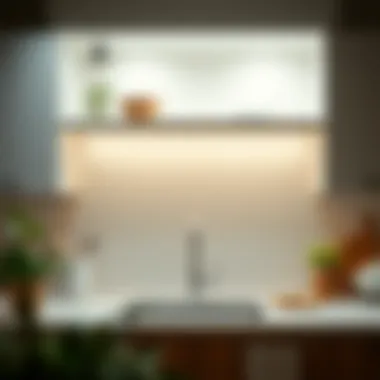
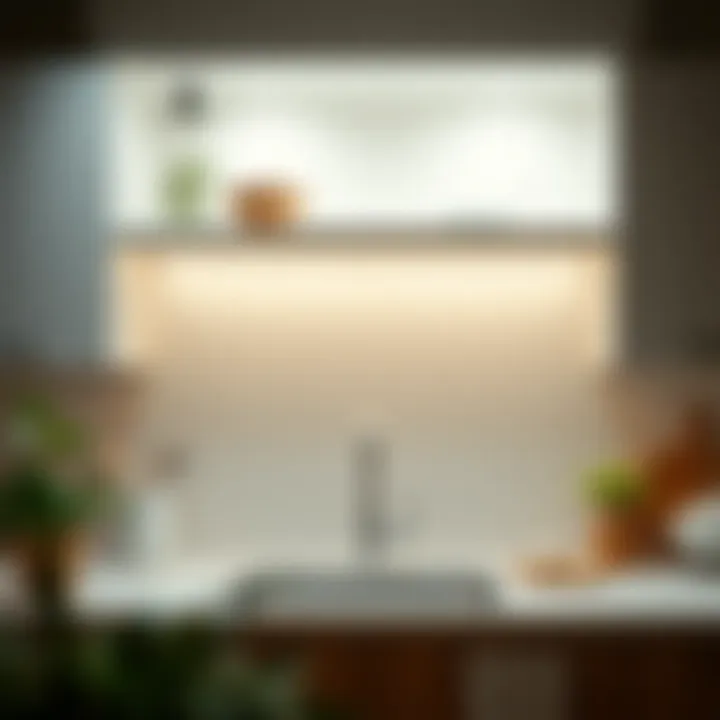
Choosing the right accent lights not only enhances the kitchen’s visual appeal but also creates an intimate atmosphere for dinner parties or family meals. Layering these lights shows off your creativity, transforming your kitchen from mere utility to a delightful gathering space.
By thoughtfully crafting the lighting strategy in your kitchen, you can create an environment that feels expansive and caters to both culinary tasks and cozy gatherings.
Color Temperature and Its Impact
When it comes to lighting in small kitchens, color temperature plays a pivotal role in shaping the eating and cooking experience. Rather than simply illuminating a space, color temperature impacts how spaces feel and how tasks are perceived. For the homeowner or interior designer, understanding this detail can be the difference between a kitchen that feels cramped and uninspiring or one that feels open and inviting.
Understanding Kelvin Ratings
Kelvin ratings refer to a scale measuring color temperatures, primarily used in lighting. This scale usually ranges from 2000K to 6500K, with lower values producing warmer, yellowish hues while higher values yield cooler, bluish tones. In practical terms:
- 2700K-3000K: Creates a cozy, warm atmosphere that's perfect for kitchens where family and friends gather.
- 3500K-4100K: Offers a balanced, neutral light that is versatile for different tasks.
- 5000K-6500K: Mimics daylight, suitable for areas where precision, such as food prep, is essential.
Utilizing appropriate Kelvin ratings allows homeowners to tailor their kitchen lighting to meet the specific daily demands and preferences. For example, a small kitchen bathed in warm light can become the heart of the home, inviting people to linger and connect.
Creating a Warm vs. Cool Atmosphere
Choosing the right color temperature helps craft the ambiance you want in your small kitchen. A warm atmosphere, often achieved through lights with Kelvin ratings around 2700K to 3000K, invitingly embraces those who enter. This type of lighting can make meals feel more special and encourage casual conversations.
Conversely, a cooler atmosphere, characterized by higher Kelvin ratings, lends a more focused and energetic vibe. This is particularly effective during meal prep, when clarity and attention to detail are vital. The right lighting can enhance productivity while simultaneously preserving that essential lively kitchen feel.
Imagine this: a couple chopping veggies under warm light while friends share stories around the table. It’s inviting yet also perfect for focused work when needed. No matter the mood desired, understanding how to manipulate color temperature lets you adapt your kitchen lighting efficiently.
"Light is a two-edged sword; it can illuminate or obscure, warm or chill. Choosing wisely enhances spaces and experiences."
Smart Lighting Technologies
In today's fast-paced world, where efficiency intersects with design, integrating smart lighting technologies into small kitchens has become a game-changer. These advancements not only enhance visibility but also contribute to a more enjoyable cooking and dining experience. Kitchens, often regarded as the heart of a home, require lighting solutions that blend functionality with the latest tech innovations. Utilizing smart controls can optimize illumination while providing flexibility to suit various moods and occasions. As a small kitchen owner, embracing such technologies means unlocking efficiency and style.
Integrating Smart Controls
When it comes to smart controls, the options are almost limitless. From voice-activated systems like Amazon's Alexa to mobile apps that adjust settings from your phone, the integration of smart lighting is a straightforward process. Consider installing smart bulbs that allow you to change brightness levels, color temperature, and even create schedules for when certain lights turn on or off. A common example includes Philips Hue, which enables you to control your kitchen's ambiance from anywhere within the house or remotely while away.
For those keen on DIY solutions, smart plugs can provide similar functionality. Simply plug your lamps or under-cabinet lighting into a smart plug, then use an app or voice command to manage power without needing to lift a finger.
"Smart lighting is not just about convenience; it's a lifestyle choice that can lead to energy savings and improved ambiance."
Benefits of Smart Lighting
Smart lighting technologies bring numerous benefits to kitchen spaces, especially for small kitchens where every inch counts. Here are some notable advantages:
- Energy Efficiency: Smart bulbs often use LED technology, which consumes less power than traditional incandescent bulbs. With dimmable options, you can save even more energy by adjusting brightness to fit your needs.
- Customization: Personalization takes the main stage. With smart lighting, users can create different scenes for cooking, entertaining, or relaxing. Want a cozy vibe for dinner? A few taps on your phone can set the scene.
- Increased Safety: Smart lights can be programmed to mimic your presence at home, discouraging potential intruders. Also, having automatic task lighting that activates when you approach ensures you never have to navigate dark spaces while handling sharp knives or hot pots.
- Convenience: Hands dirty from cooking? Simple commands to a smart speaker can illuminate your workspace without requiring you to stop what you're doing. This hands-free control is particularly useful for those who frequently entertain guests or cook for families.
Common Mistakes to Avoid
When setting the stage for a small kitchen, lighting plays a pivotal role in both function and form. However, homeowners often find themselves stepping in proverbial puddles by overlooking critical aspects that can make or break the kitchen's ambiance. Understanding the common mistakes in this domain is crucial to crafting a space that is not only well-lit but also inviting and practical.
A small kitchen is like a blank canvas; it flourishes when appropriately illuminated. Not realizing the importance of light can lead to frustration and subpar culinary experiences. Let's unpack two primary missteps that can often dim the prospects of any kitchen design.
Overly Harsh Lighting Choices
Choosing the right intensity and type of light fixtures can sometimes feel like a balancing act. The challenge lies in selecting fixtures that provide adequate illumination without creating a harsh glare.
Many homeowners select bulbs with a very high wattage, thinking that more light will solve their problems. Instead, what often happens is an environment akin to a bustling hospital, where the sterile lighting dampens creativity and comfort. It's vital to remember that kitchens are often gathering spots; harsh lighting can turn a cozy meal prep into an unpleasant affair.
To sidestep this dilemma, consider these guidelines:
- Use Warm Light Bulbs: Opt for bulbs with lower Kelvin ratings (2700K-3000K) which emit a softer glow.
- Dimmer Switches: Installing dimmers allows for flexibility, adjusting the brightness to your mood and the time of day.
- Layering: Employ multiple light sources strategically to create a balance of ambient, task, and accent lighting.
An example of avoiding harsh lighting is seen in a small kitchen redo in Portland, Oregon. The homeowner shifted from sterile fluorescent to warm LED lights under cabinets. The result was a warm, inviting space that feels more like a kitchen and less like a workspace.
Ignoring Task-Specific Needs
Ignoring task-specific needs is another common pitfall. Every kitchen has its ‘work zones’, so lighting should cater to these specific areas. Think about it: chopping vegetables requires different light than stirring a pot of sauce. When task lighting is overlooked, simple kitchen chores can become burdensome.
In small kitchens, it’s easy to just slap up one fixture and call it a day, but that often leaves areas in the dark. Here’s how to avoid this:
- Designate Work Areas: Identify zones like the stove, sink, and prep areas. Task lights like under-cabinet lights or focused pendant lights over key spots can enhance visibility.
- Consider Shadows: Pay attention to where shadows fall, particularly from overhead fixtures. Ensure that no critical zone is left in shadow.
- Brighten Up Dark Corners: For those tight spaces, adding lights that can illuminate corners can make a world of difference.
Take a look at a case study from a recent renovation in Chicago; the owners focused on illuminating the sink area with an under-cabinet bar light. This minor adjustment made a significant impact, allowing the homeowner to chop and wash vegetables effortlessly.
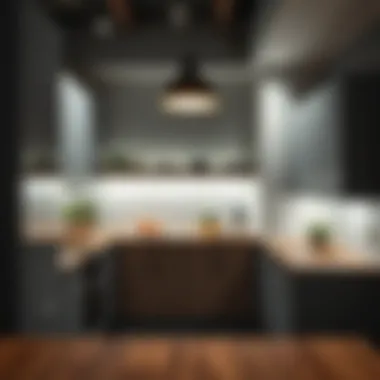
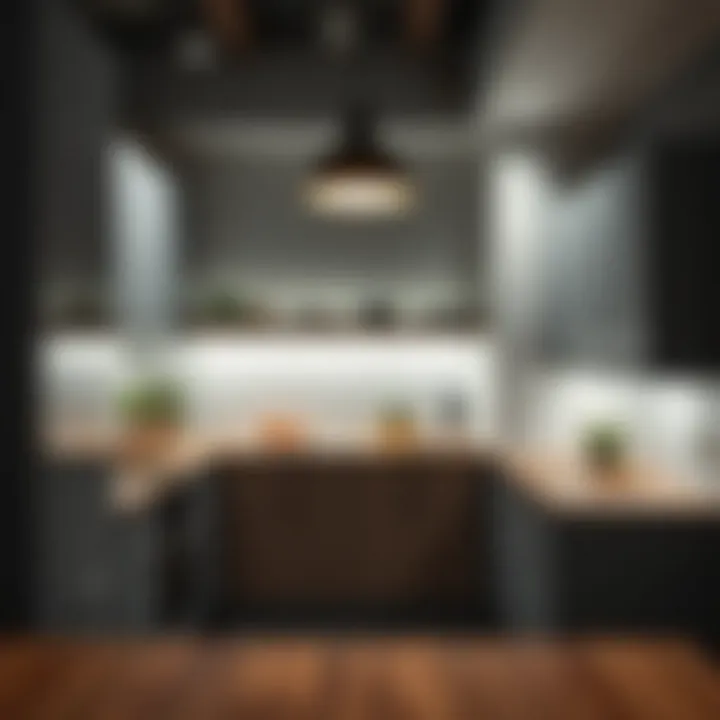
"A well-lit kitchen is not just about brightness; it’s about creating an environment where cooking is a joy, not a task."
Design Trends in Kitchen Lighting
In the realm of small kitchens, lighting is not merely a functional element; it serves as a vital component of design that can dramatically influence both the look and feel of the space. As trends continuously evolve, understanding current styles becomes key for homeowners and design enthusiasts aiming to create inviting and practical environments. Lighting trends not only enhance the aesthetic appeal but also elevate functionality by maximizing the usability of compact spaces.
Indeed, exploring design trends in kitchen lighting opens up a world of opportunities. Choosing the right fixtures can lead to improvements not just in illumination, but in how space is perceived—making it feel larger, more welcoming, or even more cozy depending on the goals. Current trends favor simplicity and sustainability, blending aesthetics with practicality.
Industrial and Minimalist Fixtures
When it comes to current trends, industrial and minimalist fixtures reign supreme. The industrial look has roots in the raw, unrefined essence of factories and warehouses. This trend incorporates materials like metal, brass, and exposed light bulbs. These fixtures are not just stylish; they're also incredibly functional. They often provide great light coverage without overwhelming the space, making them ideal for small kitchens.
- Simplicity is the driving force behind minimalist lighting. Clean lines and understated designs ensure that the kitchen remains uncluttered and visually spacious.
- Opting for pendant lights in the industrial style allows for targeted illumination over prep areas or dining nooks, providing both focus and flair.
- In smaller settings, cluster arrangements of small pendant lights can create a dazzling focal point without taking up too much visual or physical space.
By thoughtfully integrating industrial or minimalist lighting into a small kitchen, you cultivate an environment that's both effective and stylish, allowing the space to breathe while serving the required practical needs.
Sustainable Lighting Options
The demand for sustainability has grown stronger, and this extends into kitchen lighting as well. More and more homeowners are becoming conscious about their energy consumption and its impact on the environment. Choosing sustainable lighting options reflects this growing awareness and can significantly contribute to reducing one’s carbon footprint.
- LED lighting is at the forefront of sustainable options. Not only do they consume less energy compared to traditional incandescent bulbs, they also produce less heat, thereby reducing the load on air conditioning systems.
- Many LED products now come in trendy styles, making them visually appealing while still being eco-friendly. They are available in various shapes and colors, catering to the aesthetic needs of any kitchen.
- Another innovative trend is solar-powered fixtures, which utilize sunlight effectively and reduce electricity costs. They can be especially useful in kitchens with ample natural light.
"Opting for sustainable lighting is not just an investment in your kitchen; it’s an investment in the planet."
Case Studies: Successful Small Kitchen Enhancements
When it comes to illuminating small kitchens, case studies of successful enhancements can provide invaluable insights. These real-world examples bring to light the pivotal role of thoughtful lighting choices, demonstrating how design, functionality, and aesthetics come together. Homeowners often grapple with the challenge of maximizing the efficiency and appeal of their cooking spaces, especially when faced with square footage limitations. By analyzing specific case studies, readers can glean inspiration and practical strategies that work effectively in limited spaces.
Transitional Styles
Transitional kitchen designs offer a blend of classic and contemporary elements. This style aims for a harmonious balance that can adapt easily to varying tastes. A notable case involves a small kitchen where the homeowner opted for a combination of sleek stainless steel fixtures and traditional pendant lights. This choice not only provided task lighting over crucial work areas but also infused the space with character and warmth.
Here are some elements that made this transformation stand out:
- Layered Lighting: The blend of overhead lighting and under-cabinet fixtures enhanced the utility while keeping the atmosphere inviting.
- Color Consistency: A neutral color palette ensured that the light reflected positively throughout the kitchen, helping it feel more spacious.
- Versatile Fixtures: Fixtures were selected for their design adaptability, allowing for shifts in decor without requiring a complete overhaul.
Such intentional choices illustrate how transitional styling in lighting can elevate not only the function but also the beauty of small kitchens.
Contemporary Innovations
In recent years, contemporary lighting solutions have captured the imaginations of many, particularly in small kitchen environments. One standout case explored how a homeowner utilized LED strip lights along shelves and cabinetry to create a modern, sleek look that also served practical purposes.
Key features from this case include:
- Smart Technology Integration: The use of adjustable brightness settings allowed the homeowner to control the kitchen's ambiance according to the time of day or activity, switching from bright task lighting to softer evening tones effortlessly.
- Space-Saving Designs: Slim-profile fixtures that hugged the ceiling contributed to an unobtrusive feel, maintaining an open atmosphere.
- Focus on Sustainability: The energy efficiency of modern LED options not only reduced costs but also aligned with eco-conscious designs.
Collectively, these innovations demonstrate how contemporary strategies can transform small kitchens into sophisticated yet functional spaces without feeling cramped or overwhelming.
"Designing a kitchen is like composing a symphony; every light has its note; when played together, they create harmony."
Case studies like these serve as touchstones for anyone looking to make the most of their kitchen space, providing relevant takeaways that can inspire their own projects.
Final Thoughts on Lighting in Small Kitchens
Lighting in small kitchens is not just about illumination but about creating a nurturing atmosphere where culinary creativity can flourish. The right choices elevate both functionality and aesthetic appeal, enabling efficient workflows in a digestible space. When one considers the various elements discussed throughout this article, it becomes evident that strategic lighting solutions can transform compact cooking areas into vibrant hubs of activity.
Tailoring to Individual Needs
Personalization is key when planning lighting in your kitchen. Every household is unique, and so are the needs of its inhabitants. For instance, a passionate chef might require more task lighting over the countertop areas to ensure each chop and stir is done with precision. On the contrary, a family that solely uses the kitchen for meal prep may prefer softer, ambient lighting, thus creating a more relaxed environment.
Here are some considerations for tailoring your kitchen lighting:
- Assess Daily Activities: Observe how your kitchen gets used. Is it a bustling zone during breakfast or late-night snacking? These insights guide your choices.
- Consider Personal Preference: Everyone has their own vibe. Do you favor bright, crisp light or a warmer glow that makes the space feel cozy?
- Balance Function and Style: Any successful design captures function without sacrificing style. Choosing beautiful fixtures that also serve their purpose can achieve this balance.
By catering to your individual needs, you'll be able to make the most of every square inch while expressing your style.
Continual Adaptation to Trends
The world of kitchen design—much like a good recipe—thrives on a mix of tradition and innovation. Keeping up with trends in lighting can breathe new life into even the smallest of kitchens. Completion of these adjustments doesn’t merely update aesthetic appeal; it also maximizes the effectiveness of your kitchen layout.
To ensure your lighting remains current and functional:
- Stay Informed About Innovations: Technologies like LED fixtures and smart controls are all the rage now. They offer both energy efficiency and versatility in kitchen lighting.
- Consider Eco-Friendly Options: Sustainability is more than a buzzword; it's here to stay. Look into energy-efficient LEDs or solar-powered fixtures that minimize your carbon footprint.
- Integrate Seasonal Adjustments: Lighting can vary by season—consider making minor tweaks to your setup to accommodate seasonal moods—from bright and cheerful in the summer to warm and inviting in the winter.
Adapting to trends doesn’t mean you have to toss out your entire lighting scheme each year. Instead, it’s about informed updates that enhance both enjoyment and functionality.
"Significant changes in design come from a series of small adjustments that inform shifts. Today's trends often set the stage for tomorrow's standard practices."
By keeping these final thoughts in mind, it becomes clear that effective lighting solutions in small kitchens can substantially impact daily life. Through careful customization and a keen eye on evolving trends, any homeowner can turn their compact kitchen into a space that is not only efficient but also a joy to inhabit.















